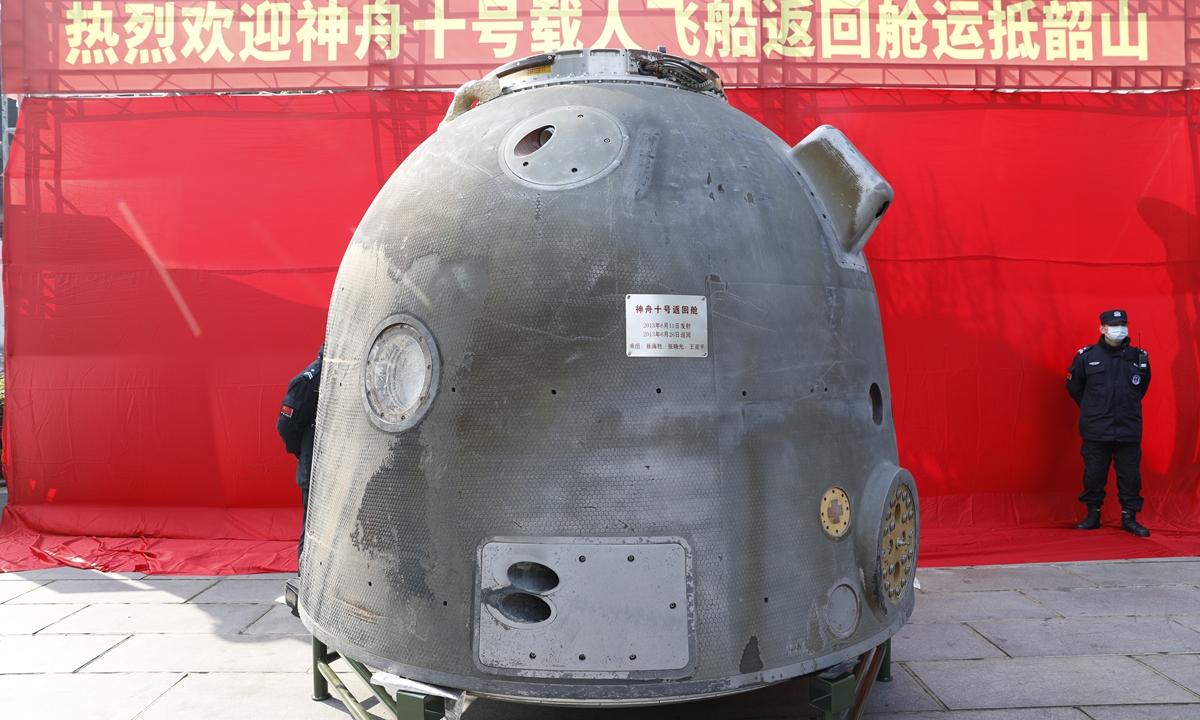China's manned spacecraft Shenzhou-10 settles in Mao's hometown
By Fan Anqi and Deng Xiaoci Source: Global Times Published: 2020/12/20 20:26:11

The reentry module of China's manned spacecraft Shenzhou-10 arrived in the hometown of the late Chinese leader Chairman Mao Zedong in Shaoshan, Central China's Hunan Province on Sunday. Photo: courtesy of the publicity department of Hunan provincial government
The reentry module of China's manned spacecraft Shenzhou-10 on Sunday arrived in the hometown of the late Chinese leader Chairman Mao Zedong in Shaoshan, Central China's Hunan Province, to honor the forerunner of China's aerospace industry and remind people of the original aspiration that guided China to advance steadily ahead in space.
The module will be exhibited in the local Shaoshan Mao Zedong Memorial Museum, a national first-grade museum, which can meet the temperature and humidity needs of the returned cabin, the publicity department of the Hunan provincial government said in a statement it sent to the Global Times on Sunday.
With the return cabin's new home in Shaoshan, Yang Guoli, curator of the Mao memorial museum, explained that the decision on where the craft would be placed was also made in consideration of the target audience. Out of the 5 million annual visits to the museum and 20 million to the city's scenic area, 45 percent are middle and primary school students.
In light of this, the value of China's aerospace achievements as well as Mao's spirit, which is manifested in his poem "We can bring down the moon from the Ninth Heaven, or catch the giant turtles in the sea," could have an increased effect when combined with the display of the Shenzhou-10 return capsule, Yang noted.
It pays a solemn tribute to Chairman Mao, the forerunner of China's aerospace industry, which also serves as a reminder of the original aspiration and glorious tradition that guide the Chinese people to advance steadily into space, observers noted.
The exhibition is also intended to promote the region's patriotic education and tourism. The museum is the only one in the country that thoroughly displays Chairman Mao's life, deeds, thoughts and personalities.
The event came after the China National Space Administration (CNSA) said on Thursday it would store some of the moon soil collected by Chang'e-5 in Shaoshan to commemorate Chairman Mao and his deep passion for space exploration. The exact location on where the samples will be held hasn't been announced.
Beyond the intention to honor the late leader, Pei Zhaoyu, deputy director of the Lunar Exploration and Space Program Center of the CNSA, explained that Hunan Province was also chosen as a site for sample preservation for its favorable geological conditions for disaster recovery and backup.
On June 11, 2013, three astronauts - Nie Haisheng, Zhang Xiaoguang and the only female astronaut of the mission Wang Yaping - embarked on a journey to the Tiangong-1 space station on a Long March 2F carrier rocket from the Jiuquan Satellite Launch Center in Northwest China's Gansu Province, thus beginning Shenzhou-10's space adventure.
The 2.6-meter-long, 2.4-meter-diameter craft, with a weight of more than 2 tons, successfully carried out automatic docking with Tiangong-1 space laboratory on June 13, 2013.
While onboard the craft, Wang Yaping, China's second woman to go into space, presented a video lecture to more than 60 million primary and middle school students on Earth, during which she demonstrated, with the help of the other two astronauts, how objects move in the microgravity environment of space.
The reentry module carrying the three astronauts separated from Tiangong-1 on June 25 after spending about two weeks in space. A day later, it landed safely in the designated area in North China's Inner Mongolia Autonomous Region, with all three astronauts in good physical condition.
The completion of the Shenzhou-10 and Tiangong-1 mission further consolidated China's space rendezvous and docking expertise, marking a new stage of success in achieving the second strategic goal of China's manned space program.
"We are dreamers," said Zhang Xiaoguang, the pilot onboard the spacecraft. "Our space dream knows no boundaries, and our hard work will never cease," he said.
Posted in: SOCIETY